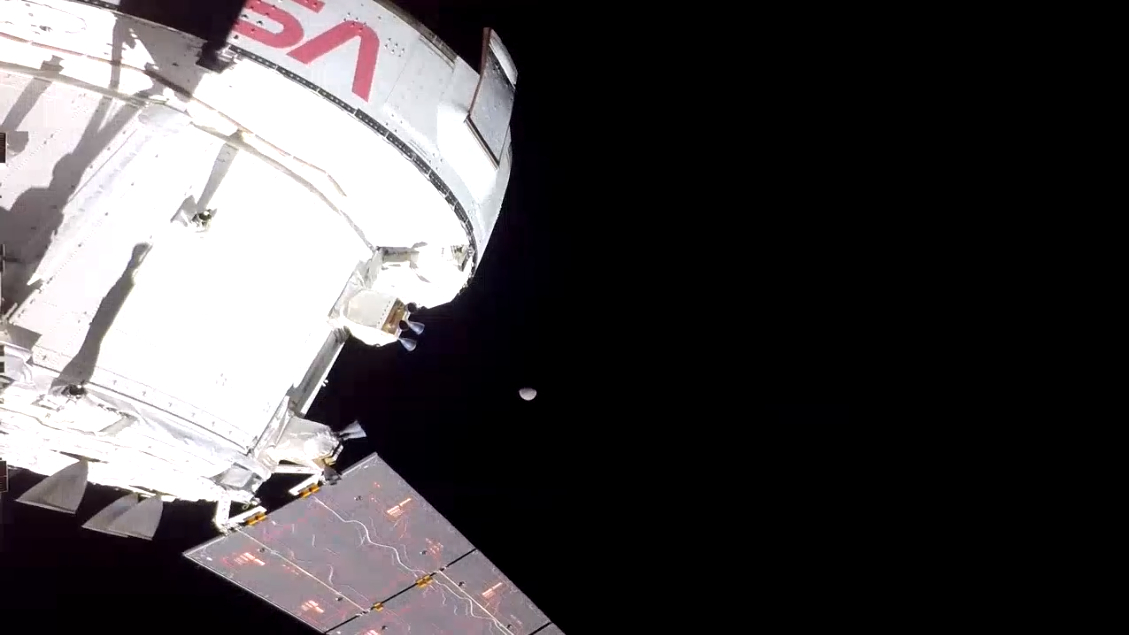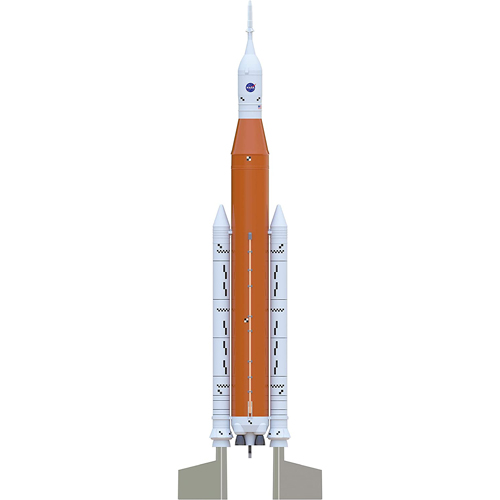Artemis 1 Orion spacecraft sees the moon for 1st time in stunning video
Orion is now over halfway to the moon for its 25-day Artemis 1 mission.
NASA's Orion spacecraft has spotted the destination of its Artemis 1 test flight the moon and captured a stunning video to mark the moment.
In a video released Friday (Nov. 18), the half-lit moon is visible in the distance with the Orion spacecraft in the foreground, complete with NASA's "worm" logo, as seen from a camera on the tip of one of the capsule's four solar wings. At the time, Orion was about halfway to the moon, NASA said in a statement.
"On the third day of the Artemis I mission, Orion maneuvered its solar arrays and captured the moon with a camera mounted on the end of the array," NASA wrote in the video description.
NASA launched Orion on is uncrewed Artemis 1 mission on Wednesday (Nov. 16) atop the agency's first Space Launch System (SLS), which is now the world's most powerful rocket. Orion will fly a 25-day trip to the moon and back on a shakedown cruise that will return to Earth on Dec. 11. NASA is using the mission as a flight as a test for its Artemis program to see if the SLS rocket and Orion are ready to fly astronauts to the moon, with a crewed lunar landing targeted for 2025.


You can launch a Space Launch System of your own with this Estes NASA SLS model rocket for a 1:200 scale version of NASA's moon megarocket. Read more about it.
The video is the latest amazing view from Orion, which is equipped with 24 cameras dotted along its exterior, solar arrays and interior to chronicle its historic test flight.
Artemis 1 launch photos: Amazing views of NASA's moon rocket debut
Live updates: NASA's Artemis 1 moon mission
In the hours just after launch, Orion's captured a crescent Earth falling behind as it made its way to the moon. Check it out below.
Get the Space.com Newsletter
Breaking space news, the latest updates on rocket launches, skywatching events and more!
NASA has also launched a new Artemis All-Access video series that will provide weekly updates on the mission as it ventures to the moon and back.
The first episode, which NASA also dropped on Friday, chronicles the first three days of the Artemis 1 mission, including stunning views of spacecraft separation from its SLS rocket upper stage, cubesat deployment milestones and an update from NASA's Dan Huot on how the mission has gone so far. Take a look in the video below to check it out.
As of early Saturday (Nov. 19), the Artemis 1 Orion spacecraft was 216,391 miles (348,247 kilometers) from Earth, 93,048 miles (149,746 km) from the moon and cruising through space at 995 mph (1,601 kph), according to NASA. You can track Orion through space on its mission through NASA's Track Artemis website.
So far, Orion's flight has gone relatively smoothly, with NASA mission managers saying it has exceeded their expectations, despite minor hiccups as engineers learn how the spacecraft performs in deep space.
On Monday morning (Nov. 21), the Artemis 1 Orion will make its closest approach to the moon in a flyby, coming within 60 miles (100 km) of the moon as it prepares to entire its wide, looping orbit.
NASA will webcast the Artemis 1 moon flyby live beginning at 7:15 a.m. EST (1215 GMT), with the time of closest approach scheduled for just after 7:57 a.m. EST (1257 GMT). Orion will enter its final orbit around the moon on Nov. 25 at 4:52 p.m. EST (2152 GMT), with NASA coverage beginning at 4:30 p.m. EST (2130 GMT). You can watch NASA's Artemis 1 Orion webcasts live on Space.com, courtesy of NASA TV.
Email Tariq Malik at tmalik@space.com or follow him @tariqjmalik. Follow us @Spacedotcom, Facebook and Instagram.
Join our Space Forums to keep talking space on the latest missions, night sky and more! And if you have a news tip, correction or comment, let us know at: community@space.com.

Tariq is the Editor-in-Chief of Space.com and joined the team in 2001, first as an intern and staff writer, and later as an editor. He covers human spaceflight, exploration and space science, as well as skywatching and entertainment. He became Space.com's Managing Editor in 2009 and Editor-in-Chief in 2019. Before joining Space.com, Tariq was a staff reporter for The Los Angeles Times covering education and city beats in La Habra, Fullerton and Huntington Beach. In October 2022, Tariq received the Harry Kolcum Award for excellence in space reporting from the National Space Club Florida Committee. He is also an Eagle Scout (yes, he has the Space Exploration merit badge) and went to Space Camp four times as a kid and a fifth time as an adult. He has journalism degrees from the University of Southern California and New York University. You can find Tariq at Space.com and as the co-host to the This Week In Space podcast with space historian Rod Pyle on the TWiT network. To see his latest project, you can follow Tariq on Twitter @tariqjmalik.









